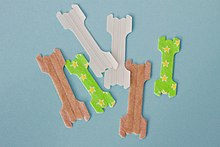
A nasal strip, external nasal dilator strip or nasal dilator strip is a type of adhesive bandage with embedded plastic ribs or splints that is applied across the bridge of the nose and sides of the nostrils, to assist in keeping the airway open. They are believed to make breathing easier and for that reason are used during athletic exertion and as an aid to reduce congestion or to prevent snoring. Various studies have indicated that they do not have a performance-enhancing effect. They are also used by race horse trainers on horses for similar reasons; they are thought to reduce airway resistance and lower the risk of exercise-induced pulmonary hemorrhage (EIPH), plus reduce fatigue and aid post-race recovery.
Human use

In humans, the nasal valve is the narrowest part of the nasal aperture and when exercising, this area is subjected to negative pressure and becomes smaller. Nasal strips adhere to the skin, holding open the anterior nasal aperture and prevent it from collapsing. When properly applied, they lift and widen the space in the nasal passage. They are a drug-free method to maintain airway flow and are available as an over the counter product. They have no reported side effects other than possible skin irritation from the adhesive.
Studies indicate that they are useful in increasing nasal cavity volume in the front three centimeters of the human nose, and for that purpose could be an alternative to decongestive nose sprays, but nasal strips are not particularly helpful for congestion in the posterior nasal apertures. They also have been shown to reduce snoring loudness and improve quality of sleep. Subjects wearing the strips in tests indicated that they believed that the strips helped them breathe more easily, and they are of particular interest to those human athletes who have to wear a mouthguard and need to be able to breathe more through their nostrils than their mouths. Studies have not necessarily demonstrated that athletic performance is increased, but people wearing them seem to have far less dyspnea or shortness of breath while exercising.
Equine use

In horses, they are viewed as helpful because the animals cannot breathe through their mouths, only through their nostrils. As with humans, the equine design helps keep the nasal valve from collapsing due to the negative pressure created by physical exertion. However, their primary benefit is preventing lung bleeding (EIPH), not directly enhancing performance. The equine version was invented by two veterinarians, James Chiapetta and Edward Blach. In the 1990s, they were inspired by the human product to attempt to create a similar device for horses. They had observed horses on treadmills and saw that, under exertion, the equine nasal passage also narrowed due to the tissue being sucked in. They worked out a licensing agreement with CNS, the company that manufactured the human "Breathe Right" brand of nasal strips in 1997 (now owned by Foundation Consumer Brands) where the company manufactured the equine form of the nasal strip, and paid royalties to Chiapetta and Blach. The equine version was first used publicly at the 1999 Breeders' Cup horse races and the 2000 Summer Olympics. In 2001, they parted ways with CNS and formed their own company, Flair, and in 2008, Chiapetta acquired Blach.
See also
References
- ^ Bhardwaj, Munish (2008-08-08). "Nasal Strips". Disabled-world.com. Retrieved 2014-05-29.
- O'Kroy, J.A. (August 2000). "Oxygen uptake and ventilatory effects of an external nasal dilator during ergometry". Med Sci Sports Exerc. 32 (8): 1491–5. doi:10.1097/00005768-200008000-00019. PMID 10949017.
- ^ Nuzzo, Regina (2014-05-24). "Straight from the horse's nose". ESPN. Retrieved 2014-05-27.
- ^ Peltonen, Lauri I.; et al. (2004). "Effects of the nasal strip and dilator on nasal breathing – a study with healthy subjects" (PDF). Rhinology. 42 (3): 122–125. PMID 15521663. Retrieved 2014-05-29.
- "Stanford Sleep Surgery – Otolaryngology". Stanford University School of Medicine. 2008-06-20. Archived from the original on 2015-03-16. Retrieved 2014-05-29.
- Høyvoll, L.R.; et al. (November 2007). "Effects of an external nasal dilator strip (ENDS) compared to xylometazolin nasal spray". Eur Arch Otorhinolaryngol. 264 (11): 1289–94. doi:10.1007/s00405-007-0345-6. PMID 17530269. S2CID 22839527.
- Overend, Tom; et al. (Jan–Mar 2000). "External Nasal Dilator Strips Do Not Affect Treadmill Performance in Subjects Wearing Mouthguards". Journal of Athletic Training. 35: 60–4. PMC 1323440. PMID 16558610.
- Kavilanz, Parija (2014-06-05). "Meet the maker of California Chrome's nasal strip". CNN Money. Retrieved 2014-06-05.